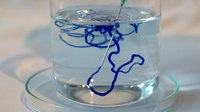
Photo from wikipedia
Abstract In this study, the wear behaviors of the solution-treated and as-extruded SiC p /AZ91D metal matrix composites with different sizes and volume fractions of SiC particles were systematically investigated… Click to show full abstract
Abstract In this study, the wear behaviors of the solution-treated and as-extruded SiC p /AZ91D metal matrix composites with different sizes and volume fractions of SiC particles were systematically investigated under different wear test parameters. The SiC particles exhibited a typical necklace-type distribution in the solution-treated composites and a homogeneous distribution in the as-extruded composites. Wear tests results showed that the wear rates of the as-extruded composites were lower than that of the solution-treated composites almost under all testing conditions and with the same SiC size and volume fraction. However, the dominant wear mechanisms for these two types of composites were different. The typical necklace-type distribution of SiC p in the solution-treated composites could effectively promote the occurrence of delamination owing to the weak bonding between SiC p and matrix in the particle aggregated regions. By contrast, as the bond between disperse SiC p and matrix was enhanced, the homogeneous distribution of SiC p in the as-extruded composites could promote the occurrence of adhesion and prevent the occurrence of delamination. Moreover, a higher applied load and higher volume fraction of SiC p obviously promoted the progress of delamination for the solution-treated composites, while the extent of the adhesive wear for the as-extruded composites was mainly associated with the increase of the applied load, sliding velocity and SiC particle size. Graphic abstract
Journal Title: Metals and Materials International
Year Published: 2020
Link to full text (if available)
Share on Social Media: Sign Up to like & get
recommendations!